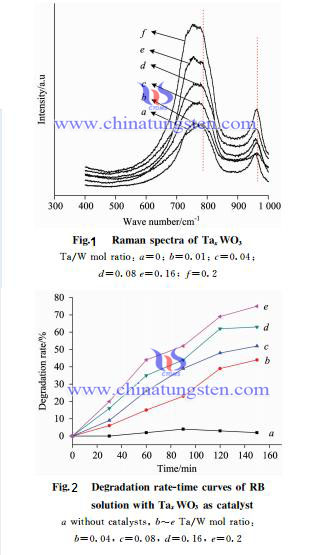TB Raman Spectra Characterization and Photocatalytic Property
- Details
- Category: Tungsten Information
- Published on Wednesday, 11 May 2016 17:59
Raman Spectra Characterization
Raman spectroscopy is a spectroscopic technique used to observe vibrational, rotational, and other low-frequency modes in a system. Raman spectroscopy is commonly used in chemistry to provide a fingerprint by which molecules can be identified. It relies on inelastic scattering, or Raman scattering, of monochromatic light, usually from a laser in the visible, near infrared, or near ultraviolet range. The laser light interacts with molecular vibrations, phonons or other excitations in the system, resulting in the energy of the laser photons being shifted up or down. The shift in energy gives information about the vibrational modes in the system. Infrared spectroscopy yields similar, but complementary, information.Typically, a sample is illuminated with a laser beam. Electromagnetic radiation from the illuminated spot is collected with a lens and sent through a monochromator. Elastic scattered radiation at the wavelength corresponding to the laser line (Rayleigh scattering) is filtered out, while the rest of the collected light is dispersed onto a detector by either a notch filter or a band pass filter.
Small changes of material TB(tungsten bronze) on the unit cell parameters and chemical environment can cause movement of Raman peak position. FIG. 1 is the Raman spectra of different amount of Ta doping, the figure shows the presence of a broad Raman band at 650 ~ 850cm-1 belongs to O-W-O bending vibration mode, and the narrow Raman peak near the 958cm-1 belongs to W = O bond stretching vibration mode. The figure shows that with the increasing of doping amount of tantalum, these two Raman peaks are moving to low frequency, peak intensity was significantly enhanced, and the vibration peaks are broadened.
There are two factors leading to the vibration peak redshift , that is the lattice expansion and smaller grains, combined XRD analysis results that we can know the tungsten oxide being doped with tantalum leads to the lattice expansion and W-O bond is elongated.
Photocatalytic Property
Figure 2 is degradation curves changes of Rhodamine B solution when the doping tantalum content of TaxWO3 as a catalyst is different under UV irradiation. The figure shows, curve a is almost no degradation of Rhodamine B when no catalyst in the solution, curves b ~ e is different content of Ta doping TaxWO3 as catalyst. With the increasing of doping amount of tantalum in TaxWO3 material, the degradation rate of Rhodamine B is significantly improved, especially when Ta / W is 0.16 in TaxWO3 material under UV light irradiation for 3h, the degradation rate of rhodamine B is 75% or more.


| Tungsten Oxide Supplier: Chinatungsten Online www.tungsten-oxide.com | Tel.: 86 592 5129696; Fax: 86 592 5129797;Email:sales@chinatungsten.com |
| Tungsten News & Prices, 3G Version: http://3g.chinatungsten.com | Molybdenum News & Molybdenum Price: http://news.molybdenum.com.cn |



 sales@chinatungsten.com
sales@chinatungsten.com